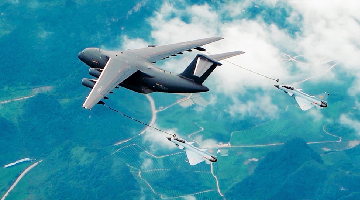
The US Department of Defense released the unclassified version of 2022 Missile Defense Review report on October 27. American media said the report reiterated the primary importance of homeland missile defense with special emphasis on air defense and anti-missile fortifications in Guam. As the Biden administration’s overarching guideline on missile defense, the document is considered to be of great importance for directing the US military’s air defense and anti-missile system development. But analysts generally believed the latest report is just harping on the same string compared with previous ones and it doesn’t have a clear execution plan.
10月27日,美国国防部发布2022年版《导弹防御评估报告》的解密版本。美国媒体称,该报告重申美国本土导弹防御的首要地位,重点提及关岛的防空反导建设,作为拜登政府关于导弹防御的纲领性文件,对于指导美军防空反导系统发展具有重要意义。不过,分析人士普遍认为,这份报告相比之前的版本仍是老调重弹,而且缺乏明确的执行计划。
UAS threat overplayed
着力渲染无人机威胁
The previous Missile Defense Review report was released by the Trump administration in 2019, which put a missile defense plan against the background of major-country competition for the first time. The 2022 report reflects America’s current missile defense policy to a large extent by emphasizing the “full spectrum of air and missile threats”, particularly UAS, which is described as “an inexpensive, accessible, flexible, expendable… way” to carry out tactical-level strikes as well as larger scale attacks.It states that “UAS can have similar lethality to cruise missiles and can launch from a wide array of locations, virtually undetected. UAS are generally not perceived by adversaries as having the same destabilizing geostrategic implications as larger missile forces, making them an increasingly preferred method to carry out tactical-level strikes.” Besides, the continuous development of UAS technology has also expanded the scope of its usage.
2019年,特朗普政府发布了上一版的《导弹防御评估报告》。2019年版报告首次将导弹防御计划置于大国竞争背景下。2022年版《导弹防御评估报告》在很大程度上反映出美国当前的导弹防御政策。新版报告尤其强调美军应关注“更全面的空中和导弹威胁”,特别提及无人机系统。报告认为,无人机系统具有廉价、灵活、可消耗等特点,可以进行战术级攻击,也可以完成大规模打击。报告称,无人航空器具有与巡航导弹相似的杀伤力,可以从广泛的区域发射且很难被发现,再加上对手通常不认为无人机具备与巡航导弹相同的打击效果,使其成为实施战术级打击的首选装备。同时,随着无人航空系统的技术不断发展,其使用范围将进一步拓展。
According to the report, the US will continue to develop active and passive defenses against regional hypersonic missile threats, and pursue a persistent and resilient sensor network to detect, track and intercept all hypersonic weapons.
此外,报告称,美国将继续发展针对高超音速导弹威胁的主动和被动防御系统,搭建持久且具有弹性的传感器网络,以探测识别高超音速武器并实施拦截。
Homeland defense the top priority
首要任务是本土防御
The report restresses homeland missile defense as the top priority in America’s missile defense strategy, and that the country will continue to upgrade and develop ground-based midcourse defense (GMD) systems.
报告重申,本土导弹防御是美国导弹防御的首要任务。美国将继续升级和发展陆基中段防御系统。
It believes the US military needs to continue developing Next Generation Interceptor (NGI), which is expected to be deployed around 2028 and gradually replace the existing interceptors. According to a DoD official, they plan to buy 20 new interceptors, for which US$2.8 billion has been allocated from the 2023FY budget. American media reckoned that the country’s ground-based missile defense systems will mainly be used to cope with ballistic missile threats from medium-sized and small countries but not capable enough to counter major countries’ nuclear arsenal.
报告认为,美军需要继续开发下一代拦截弹,预计将于2028年左右部署,并逐步取代当前装备的拦截弹。美国国防部官员表示,目前计划购买20枚新拦截弹,2023财年预算已为此划拨28亿美元。美国媒体认为,美军陆基导弹防御系统主要用于应对来自中小国家的弹道导弹威胁,“不足以对付大国的核武库”。
Another key region the report pays close attention to is Guam, which is considered part of the US homeland and a key logistics hub in the Indo-Pacific region. According to the report, “within the context of homeland defense, an attack on Guam or any other US territory by any adversary will be considered a direct attack on the US.” Additionally, as Guam is home to key regional power projection platform and logistics nodes, it is necessary to first and foremost implement the construction and upgrade plan for the ongoing missile defense system project there while enhancing regional defense and deterrence through intensified cooperation with allies and partners in joint air and missile defense.
报告关注的另一个重点地域是关岛。报告认为关岛是“美国本土的一部分”,并且是“美国在印太地区的关键作战后勤枢纽”,并明确表示在国土防御范围内,任何对手对关岛或其他美国领土的攻击,都将被视为对美国的直接攻击。报告认为,关岛是重要的区域力量投送平台和后勤节点所在地,因此需要优先落实已经在建的关岛导弹防御系统建设升级计划,同时通过与盟国和伙伴国在联合防空和导弹防御方面加强合作,提升地区防御力和威慑力。
Many issues left in limbo
诸多问题悬而未决
Analysts generally held that this type of report released by the US is getting increasingly like make-do. First, it doesn’t have a specific timetable or clearly planned stages for addressing key issues. Some American experts said the report proposes to introduce hypersonic defense systems and space sensors for the defense of Guam, but it doesn’t give a timeline to evaluate whether those systems and devices can be used within 10 years.
分析人士普遍认为,美国的此类报告越来越像应付差事。首先,针对关键问题缺乏时间表和阶段划分。有美国专家表示:“报告提出保卫关岛需要装备高超音速防御系统和太空传感器,但没有给出具体的时间节点来评估它们能否在10年内启用。”
Second, some parts of the report are vague. For instance, it doesn’t clarify America’s defense policy against missiles fired by major countries. The report reaffirms the previous stance that the US will fully rely on nuclear deterrence rather than missile defense to defend the homeland from ballistic missile attacks by major countries. It also commits to defending Guam as part of homeland, and suggests applying defense systems to keep the homeland from cruise missile attacks by major countries.
其次,报告中的部分内容含糊不清。比如,未能澄清美国针对大国导弹的防御政策。报告虽然重申之前的立场,即完全依靠核威慑而不是导弹防御来保卫本土免受大国的弹道导弹攻击,但随后承诺将关岛作为本土的一部分进行防护,还提出利用防御系统保卫本土免受大国巡航导弹的攻击。
Besides, the report won’t change the congress’ attitude. It stresses competing with other countries in advanced technologies, such as hypersonic weapons, but the Senate is opposed to providing extra funds for the “glide-phase interceptor” currently developed by the Missile Defense Agency to intercept hypersonic missiles and isn’t likely to allocate too much money for similar programs in the future either.
此外,这份报告难以改变美国国会的态度。报告强调要与其他国家在先进技术,如高超音速武器领域展开竞争,而美国参议院反对为导弹防御局正在开发的用于拦截高超音速导弹的“滑翔段拦截弹”提供额外资金,未来也很难为此类项目划拨大量经费。









